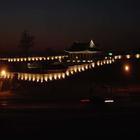Hwaseong Fortress, A Majestic Blend of History and Military Ingenuity
Suwon, Gyeonggi-do, South Korea
4.3
Introduction

Address Suwon, Gyeonggi-do, South Korea
 A grassland in front of the city gate
A grassland in front of the city gate
 A grassland in front of the city gate
A grassland in front of the city gate